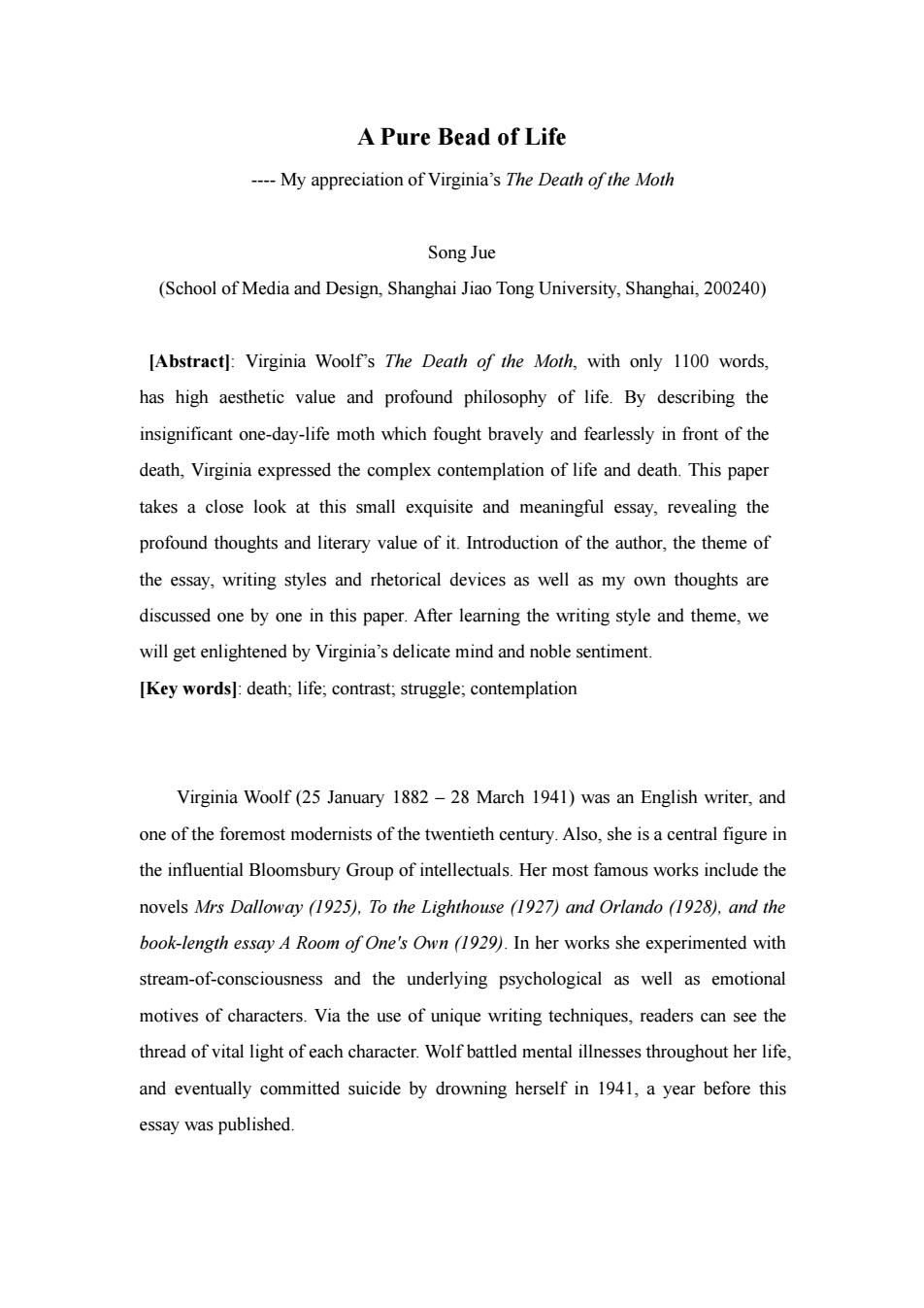
A Pure Bead of Life ----My appreciation of Virginia's The Death of the Moth Song Jue (School of Media and Design,Shanghai Jiao Tong University,Shanghai,200240) [Abstract]:Virginia Woolf's The Death of the Moth,with only 1100 words, has high aesthetic value and profound philosophy of life.By describing the insignificant one-day-life moth which fought bravely and fearlessly in front of the death,Virginia expressed the complex contemplation of life and death.This paper takes a close look at this small exquisite and meaningful essay,revealing the profound thoughts and literary value of it.Introduction of the author,the theme of the essay,writing styles and rhetorical devices as well as my own thoughts are discussed one by one in this paper.After learning the writing style and theme,we will get enlightened by Virginia's delicate mind and noble sentiment. [Key words]:death;life;contrast;struggle;contemplation Virginia Woolf(25 January 1882-28 March 1941)was an English writer,and one of the foremost modernists of the twentieth century.Also,she is a central figure in the influential Bloomsbury Group of intellectuals.Her most famous works include the novels Mrs Dalloway (1925),To the Lighthouse (1927)and Orlando (1928),and the book-length essay A Room of One's Own (1929).In her works she experimented with stream-of-consciousness and the underlying psychological as well as emotional motives of characters.Via the use of unique writing techniques,readers can see the thread of vital light of each character.Wolf battled mental illnesses throughout her life, and eventually committed suicide by drowning herself in 1941,a year before this essay was published
A Pure Bead of Life ---- My appreciation of Virginia’s The Death of the Moth Song Jue (School of Media and Design, Shanghai Jiao Tong University, Shanghai, 200240) [Abstract]: Virginia Woolf’s The Death of the Moth, with only 1100 words, has high aesthetic value and profound philosophy of life. By describing the insignificant one-day-life moth which fought bravely and fearlessly in front of the death, Virginia expressed the complex contemplation of life and death. This paper takes a close look at this small exquisite and meaningful essay, revealing the profound thoughts and literary value of it. Introduction of the author, the theme of the essay, writing styles and rhetorical devices as well as my own thoughts are discussed one by one in this paper. After learning the writing style and theme, we will get enlightened by Virginia’s delicate mind and noble sentiment. [Key words]: death; life; contrast; struggle; contemplation Virginia Woolf (25 January 1882 – 28 March 1941) was an English writer, and one of the foremost modernists of the twentieth century. Also, she is a central figure in the influential Bloomsbury Group of intellectuals. Her most famous works include the novels Mrs Dalloway (1925), To the Lighthouse (1927) and Orlando (1928), and the book-length essay A Room of One's Own (1929). In her works she experimented with stream-of-consciousness and the underlying psychological as well as emotional motives of characters. Via the use of unique writing techniques, readers can see the thread of vital light of each character. Wolf battled mental illnesses throughout her life, and eventually committed suicide by drowning herself in 1941, a year before this essay was published
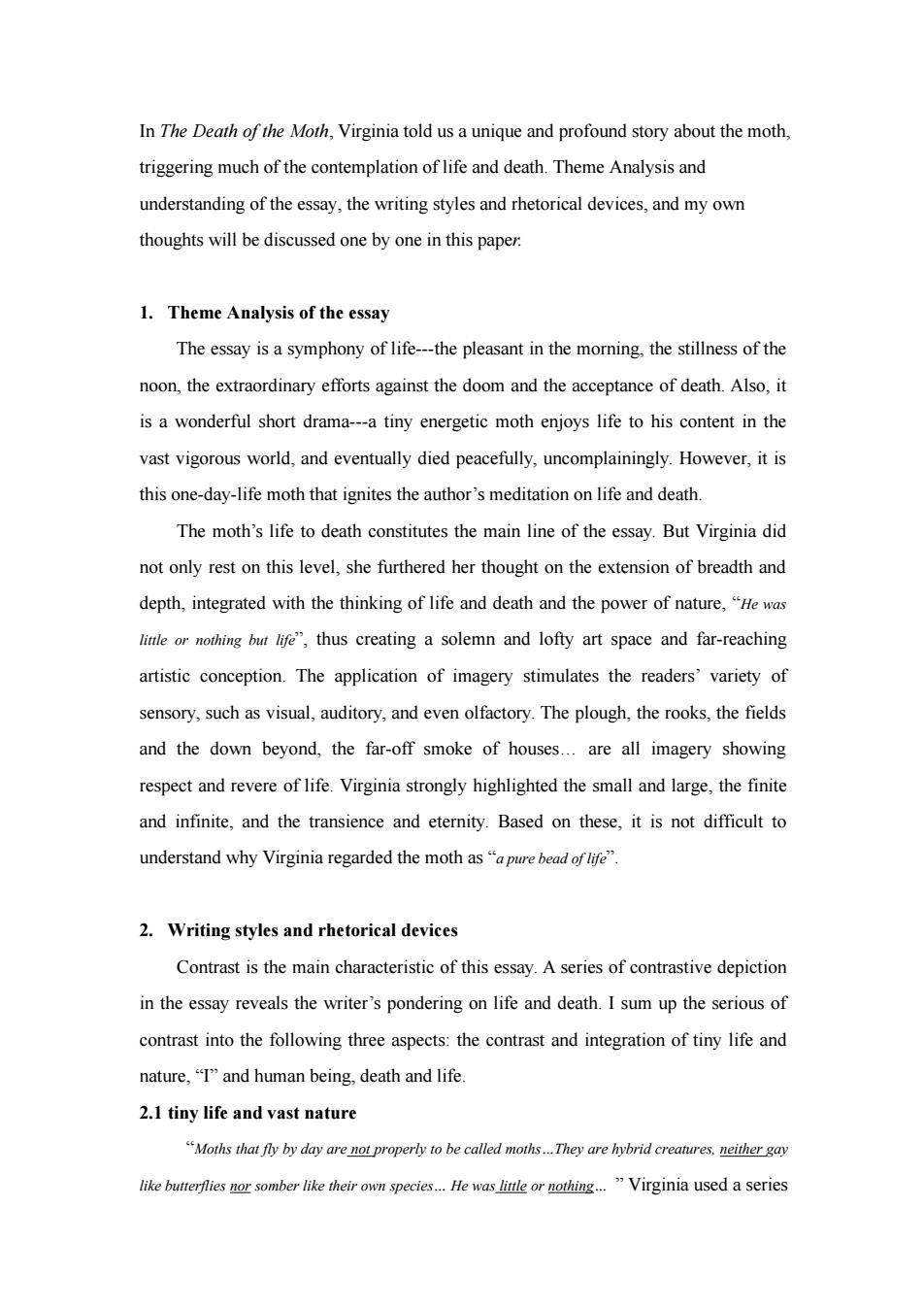
In The Death of the Moth,Virginia told us a unique and profound story about the moth, triggering much of the contemplation of life and death.Theme Analysis and understanding of the essay,the writing styles and rhetorical devices,and my own thoughts will be discussed one by one in this paper: 1.Theme Analysis of the essay The essay is a symphony of life---the pleasant in the morning,the stillness of the noon,the extraordinary efforts against the doom and the acceptance of death.Also,it is a wonderful short drama---a tiny energetic moth enjoys life to his content in the vast vigorous world,and eventually died peacefully,uncomplainingly.However,it is this one-day-life moth that ignites the author's meditation on life and death. The moth's life to death constitutes the main line of the essay.But Virginia did not only rest on this level,she furthered her thought on the extension of breadth and depth,integrated with the thinking of life and death and the power of nature,"He was litle or nothing but life",thus creating a solemn and lofty art space and far-reaching artistic conception.The application of imagery stimulates the readers'variety of sensory,such as visual,auditory,and even olfactory.The plough,the rooks,the fields and the down beyond,the far-off smoke of houses...are all imagery showing respect and revere of life.Virginia strongly highlighted the small and large,the finite and infinite,and the transience and eternity.Based on these,it is not difficult to understand why Virginia regarded the moth as"a pure bead of life". 2.Writing styles and rhetorical devices Contrast is the main characteristic of this essay.A series of contrastive depiction in the essay reveals the writer's pondering on life and death.I sum up the serious of contrast into the following three aspects:the contrast and integration of tiny life and nature,"I"and human being,death and life. 2.1 tiny life and vast nature "Moths that fly by day are not properly to be called moths...They are hybrid creatures,neither gay like butterflies nor somber like their own species...He was little or nothing..."Virginia used a series
In The Death of the Moth, Virginia told us a unique and profound story about the moth, triggering much of the contemplation of life and death. Theme Analysis and understanding of the essay, the writing styles and rhetorical devices, and my own thoughts will be discussed one by one in this paper. 1. Theme Analysis of the essay The essay is a symphony of life---the pleasant in the morning, the stillness of the noon, the extraordinary efforts against the doom and the acceptance of death. Also, it is a wonderful short drama---a tiny energetic moth enjoys life to his content in the vast vigorous world, and eventually died peacefully, uncomplainingly. However, it is this one-day-life moth that ignites the author’s meditation on life and death. The moth’s life to death constitutes the main line of the essay. But Virginia did not only rest on this level, she furthered her thought on the extension of breadth and depth, integrated with the thinking of life and death and the power of nature, “He was little or nothing but life”, thus creating a solemn and lofty art space and far-reaching artistic conception. The application of imagery stimulates the readers’ variety of sensory, such as visual, auditory, and even olfactory. The plough, the rooks, the fields and the down beyond, the far-off smoke of houses… are all imagery showing respect and revere of life. Virginia strongly highlighted the small and large, the finite and infinite, and the transience and eternity. Based on these, it is not difficult to understand why Virginia regarded the moth as “a pure bead of life”. 2. Writing styles and rhetorical devices Contrast is the main characteristic of this essay. A series of contrastive depiction in the essay reveals the writer’s pondering on life and death. I sum up the serious of contrast into the following three aspects: the contrast and integration of tiny life and nature, “I” and human being, death and life. 2.1 tiny life and vast nature “Moths that fly by day are not properly to be called moths…They are hybrid creatures, neither gay like butterflies nor somber like their own species… He was little or nothing… ” Virginia used a series
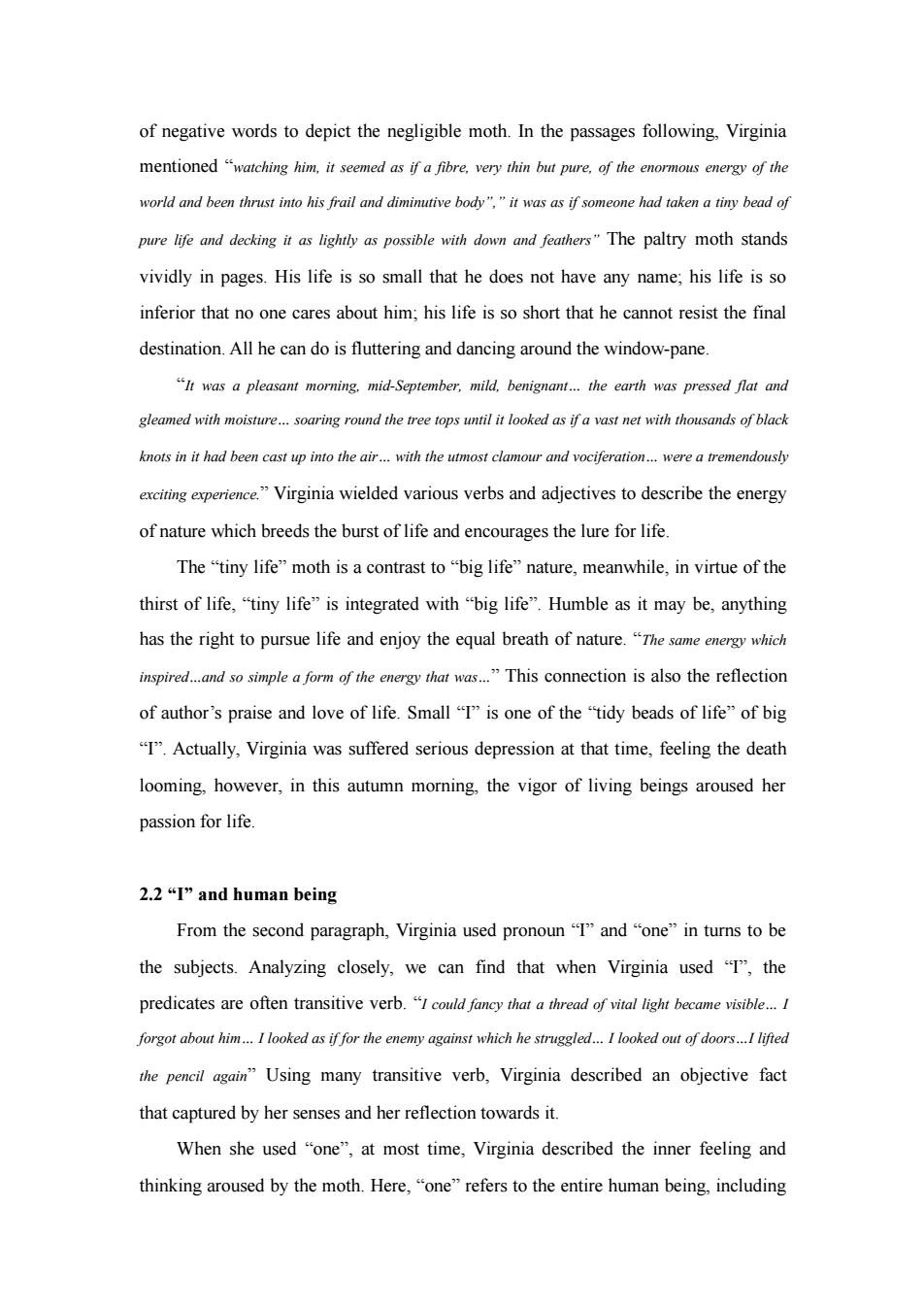
of negative words to depict the negligible moth.In the passages following,Virginia mentioned "watching him.it seemed as if a fibre,very thin but pure.of the enormous energy of the world and been thrust into his frail and diminutive body","it was as if someone had taken a tiny bead of pure life and decking it as lightly as possible with down and feathers"The paltry moth stands vividly in pages.His life is so small that he does not have any name;his life is so inferior that no one cares about him;his life is so short that he cannot resist the final destination.All he can do is fluttering and dancing around the window-pane. "It was a pleasant morning.mid-September,mild.benignant...the earth was pressed flat and gleamed with moisture...soaring round the tree tops until it looked as if a vast net with thousands of black knots in it had been cast up into the air...with the utmost clamour and vociferation...were a tremendoushy exciting experience."Virginia wielded various verbs and adjectives to describe the energy of nature which breeds the burst of life and encourages the lure for life. The "tiny life"moth is a contrast to "big life"nature,meanwhile,in virtue of the thirst of life,“tiny life”is integrated with“big life”,Humble as it may be,anything has the right to pursue life and enjoy the equal breath of nature."The same energy which inspired...and so simple a form of the energy that was..."This connection is also the reflection of author's praise and love of life.Small "I"is one of the "tidy beads of life"of big "I".Actually,Virginia was suffered serious depression at that time,feeling the death looming,however,in this autumn morning,the vigor of living beings aroused her passion for life. 2.2“T"and human being From the second paragraph,Virginia used pronoun "I"and "one"in turns to be the subjects.Analyzing closely,we can find that when Virginia used "I",the predicates are often transitive verb."I could fancy that a thread of vital light became visible...I forgot about him...I looked as if for the enemy against which he struggled...I looked out of doors...I lifted the pencil again"Using many transitive verb,Virginia described an objective fact that captured by her senses and her reflection towards it. When she used "one",at most time,Virginia described the inner feeling and thinking aroused by the moth.Here,"one"refers to the entire human being,including
of negative words to depict the negligible moth. In the passages following, Virginia mentioned “watching him, it seemed as if a fibre, very thin but pure, of the enormous energy of the world and been thrust into his frail and diminutive body”,” it was as if someone had taken a tiny bead of pure life and decking it as lightly as possible with down and feathers” The paltry moth stands vividly in pages. His life is so small that he does not have any name; his life is so inferior that no one cares about him; his life is so short that he cannot resist the final destination. All he can do is fluttering and dancing around the window-pane. “It was a pleasant morning, mid-September, mild, benignant… the earth was pressed flat and gleamed with moisture… soaring round the tree tops until it looked as if a vast net with thousands of black knots in it had been cast up into the air… with the utmost clamour and vociferation… were a tremendously exciting experience.” Virginia wielded various verbs and adjectives to describe the energy of nature which breeds the burst of life and encourages the lure for life. The “tiny life” moth is a contrast to “big life” nature, meanwhile, in virtue of the thirst of life, “tiny life” is integrated with “big life”. Humble as it may be, anything has the right to pursue life and enjoy the equal breath of nature. “The same energy which inspired…and so simple a form of the energy that was…” This connection is also the reflection of author’s praise and love of life. Small “I” is one of the “tidy beads of life” of big “I”. Actually, Virginia was suffered serious depression at that time, feeling the death looming, however, in this autumn morning, the vigor of living beings aroused her passion for life. 2.2 “I” and human being From the second paragraph, Virginia used pronoun “I” and “one” in turns to be the subjects. Analyzing closely, we can find that when Virginia used “I”, the predicates are often transitive verb. “I could fancy that a thread of vital light became visible… I forgot about him… I looked as if for the enemy against which he struggled… I looked out of doors…I lifted the pencil again” Using many transitive verb, Virginia described an objective fact that captured by her senses and her reflection towards it. When she used “one”, at most time, Virginia described the inner feeling and thinking aroused by the moth. Here, “one” refers to the entire human being, including
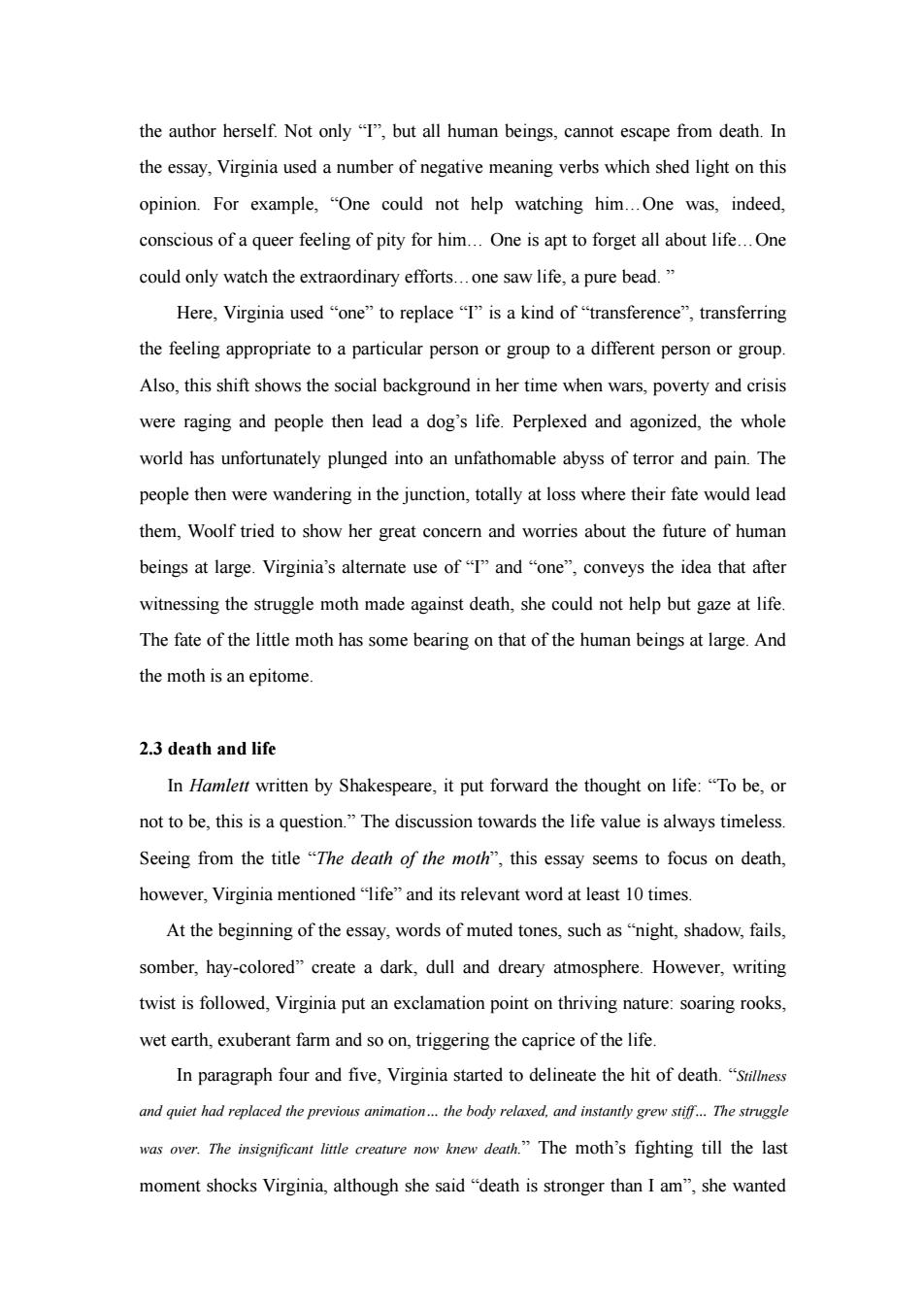
the author herself.Not only "I",but all human beings,cannot escape from death.In the essay,Virginia used a number of negative meaning verbs which shed light on this opinion.For example,"One could not help watching him...One was,indeed, conscious of a queer feeling of pity for him...One is apt to forget all about life...One could only watch the extraordinary efforts...one saw life,a pure bead. Here,Virginia used“one”to replace"I''is a kind of“transference”,transferring the feeling appropriate to a particular person or group to a different person or group. Also,this shift shows the social background in her time when wars,poverty and crisis were raging and people then lead a dog's life.Perplexed and agonized,the whole world has unfortunately plunged into an unfathomable abyss of terror and pain.The people then were wandering in the junction,totally at loss where their fate would lead them,Woolf tried to show her great concern and worries about the future of human beings at large.Virginia's alternate use of"I"and "one",conveys the idea that after witnessing the struggle moth made against death,she could not help but gaze at life. The fate of the little moth has some bearing on that of the human beings at large.And the moth is an epitome. 2.3 death and life In Hamlett written by Shakespeare,it put forward the thought on life:"To be,or not to be,this is a question."The discussion towards the life value is always timeless. Seeing from the title "The death of the moth",this essay seems to focus on death, however,Virginia mentioned "life"and its relevant word at least 10 times. At the beginning of the essay,words of muted tones,such as"night,shadow,fails, somber,hay-colored"create a dark,dull and dreary atmosphere.However,writing twist is followed,Virginia put an exclamation point on thriving nature:soaring rooks, wet earth,exuberant farm and so on,triggering the caprice of the life. In paragraph four and five,Virginia started to delineate the hit of death."Srillness and quiet had replaced the previous animation...the body relaxed,and instantly grew stiff...The struggle was over.The insignificant little creature now knew death."The moth's fighting till the last moment shocks Virginia,although she said "death is stronger than I am",she wanted
the author herself. Not only “I”, but all human beings, cannot escape from death. In the essay, Virginia used a number of negative meaning verbs which shed light on this opinion. For example, “One could not help watching him…One was, indeed, conscious of a queer feeling of pity for him… One is apt to forget all about life…One could only watch the extraordinary efforts…one saw life, a pure bead. ” Here, Virginia used “one” to replace “I” is a kind of “transference”, transferring the feeling appropriate to a particular person or group to a different person or group. Also, this shift shows the social background in her time when wars, poverty and crisis were raging and people then lead a dog’s life. Perplexed and agonized, the whole world has unfortunately plunged into an unfathomable abyss of terror and pain. The people then were wandering in the junction, totally at loss where their fate would lead them, Woolf tried to show her great concern and worries about the future of human beings at large. Virginia’s alternate use of “I” and “one”, conveys the idea that after witnessing the struggle moth made against death, she could not help but gaze at life. The fate of the little moth has some bearing on that of the human beings at large. And the moth is an epitome. 2.3 death and life In Hamlett written by Shakespeare, it put forward the thought on life: “To be, or not to be, this is a question.” The discussion towards the life value is always timeless. Seeing from the title “The death of the moth”, this essay seems to focus on death, however, Virginia mentioned “life” and its relevant word at least 10 times. At the beginning of the essay, words of muted tones, such as “night, shadow, fails, somber, hay-colored” create a dark, dull and dreary atmosphere. However, writing twist is followed, Virginia put an exclamation point on thriving nature: soaring rooks, wet earth, exuberant farm and so on, triggering the caprice of the life. In paragraph four and five, Virginia started to delineate the hit of death. “Stillness and quiet had replaced the previous animation… the body relaxed, and instantly grew stif … The struggle was over. The insignificant little creature now knew death.” The moth’s fighting till the last moment shocks Virginia, although she said “death is stronger than I am”, she wanted
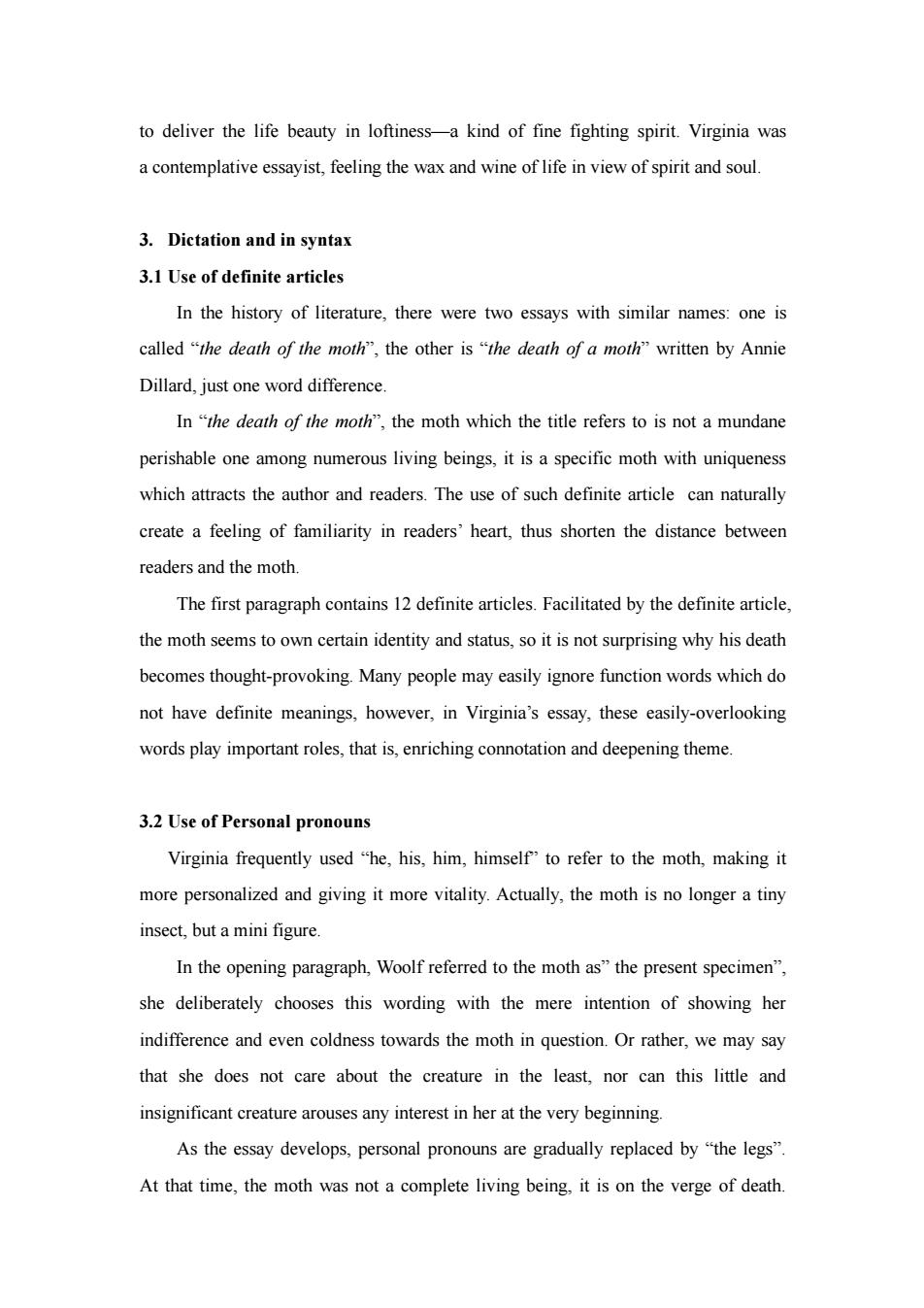
to deliver the life beauty in loftiness-a kind of fine fighting spirit.Virginia was a contemplative essayist,feeling the wax and wine of life in view of spirit and soul. 3.Dictation and in syntax 3.1 Use of definite articles In the history of literature,there were two essays with similar names:one is called "the death of the moth",the other is "the death of a moth"written by Annie Dillard,just one word difference. In "the death of the moth",the moth which the title refers to is not a mundane perishable one among numerous living beings,it is a specific moth with uniqueness which attracts the author and readers.The use of such definite article can naturally create a feeling of familiarity in readers'heart,thus shorten the distance between readers and the moth. The first paragraph contains 12 definite articles.Facilitated by the definite article, the moth seems to own certain identity and status,so it is not surprising why his death becomes thought-provoking.Many people may easily ignore function words which do not have definite meanings,however,in Virginia's essay,these easily-overlooking words play important roles,that is,enriching connotation and deepening theme. 3.2 Use of Personal pronouns Virginia frequently used "he,his,him,himself'to refer to the moth,making it more personalized and giving it more vitality.Actually,the moth is no longer a tiny insect,but a mini figure. In the opening paragraph,Woolf referred to the moth as"the present specimen", she deliberately chooses this wording with the mere intention of showing her indifference and even coldness towards the moth in question.Or rather,we may say that she does not care about the creature in the least,nor can this little and insignificant creature arouses any interest in her at the very beginning. As the essay develops,personal pronouns are gradually replaced by "the legs". At that time,the moth was not a complete living being,it is on the verge of death
to deliver the life beauty in loftiness—a kind of fine fighting spirit. Virginia was a contemplative essayist, feeling the wax and wine of life in view of spirit and soul. 3. Dictation and in syntax 3.1 Use of definite articles In the history of literature, there were two essays with similar names: one is called “the death of the moth”, the other is “the death of a moth” written by Annie Dillard, just one word difference. In “the death of the moth”, the moth which the title refers to is not a mundane perishable one among numerous living beings, it is a specific moth with uniqueness which attracts the author and readers. The use of such definite article can naturally create a feeling of familiarity in readers’ heart, thus shorten the distance between readers and the moth. The first paragraph contains 12 definite articles. Facilitated by the definite article, the moth seems to own certain identity and status, so it is not surprising why his death becomes thought-provoking. Many people may easily ignore function words which do not have definite meanings, however, in Virginia’s essay, these easily-overlooking words play important roles, that is, enriching connotation and deepening theme. 3.2 Use of Personal pronouns Virginia frequently used “he, his, him, himself” to refer to the moth, making it more personalized and giving it more vitality. Actually, the moth is no longer a tiny insect, but a mini figure. In the opening paragraph, Woolf referred to the moth as” the present specimen”, she deliberately chooses this wording with the mere intention of showing her indifference and even coldness towards the moth in question. Or rather, we may say that she does not care about the creature in the least, nor can this little and insignificant creature arouses any interest in her at the very beginning. As the essay develops, personal pronouns are gradually replaced by “the legs”. At that time, the moth was not a complete living being, it is on the verge of death